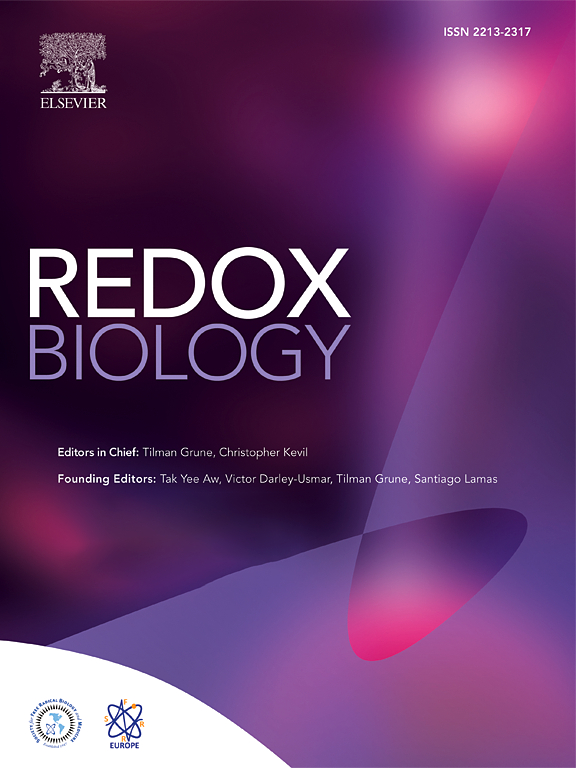Mechano-activated connexin hemichannels mediate intercellular glutathione transport and support lens redox homeostasis
IF 10.7
1区 生物学
Q1 BIOCHEMISTRY & MOLECULAR BIOLOGY
引用次数: 0
Abstract
Redox homeostasis and transparency in the ocular lens are closely associated with the distribution of the antioxidant reduced glutathione (GSH). While the synthesis and recycling of GSH have been well characterized, the mechanisms governing its intercellular transport within the lens remain largely elusive. Here, we identified a GSH transport pathway mediated by connexin (Cx) hemichannels in both lens epithelial and fiber cells that has not been fully characterized previously. Through a combination of fluid flow shear stress (FFSS) stimulation, in vitro and ex vivo models, and gene knockout mouse models, we demonstrate that Cx43 and Cx50 hemichannels in lens epithelial cells facilitate GSH efflux in response to mechanical stimuli. Notably, Cx43 hemichannels exhibited higher opening efficiency and greater GSH transport capacity than Cx50 hemichannels under FFSS. The extracellular GSH released from epithelial cells was then taken up by activated Cx50 hemichannels in fiber cells under FFSS, effectively reducing oxidative stress and promoting cell survival. This intercellular relay of GSH between epithelial and fiber cells via mechanosensitive Cx hemichannels suggests a novel mechanism for regulating redox balance within the lens. This pathway may be essential for preserving lens homeostasis and offers new insight into lens physiology and potential therapeutic strategies for preventing or delaying cataract formation.
机械激活的连接蛋白半通道介导细胞间谷胱甘肽运输和支持晶状体氧化还原稳态
晶状体的氧化还原稳态和透明度与抗氧化剂还原性谷胱甘肽(GSH)的分布密切相关。虽然谷胱甘肽的合成和再循环已被很好地表征,但控制其在晶体内的细胞间运输的机制仍在很大程度上难以捉摸。在这里,我们在晶状体上皮细胞和纤维细胞中发现了一种由连接蛋白(Cx)半通道介导的谷胱甘肽运输途径,这在以前没有得到充分的表征。通过流体流动剪切应力(FFSS)刺激、体外和离体模型以及基因敲除小鼠模型的组合,我们证明晶状体上皮细胞中的Cx43和Cx50半通道在机械刺激下促进GSH外排。值得注意的是,在FFSS作用下,Cx43半通道比Cx50半通道具有更高的开放效率和更大的GSH运输能力。在FFSS下,上皮细胞释放的胞外谷胱甘肽被纤维细胞活化的Cx50半通道吸收,有效降低氧化应激,促进细胞存活。这种谷胱甘肽通过机械敏感的Cx半通道在上皮细胞和纤维细胞之间的细胞间传递表明了一种调节晶状体内氧化还原平衡的新机制。这一途径可能对维持晶状体稳态至关重要,并为晶状体生理学和预防或延缓白内障形成的潜在治疗策略提供了新的见解。
本文章由计算机程序翻译,如有差异,请以英文原文为准。
求助全文
约1分钟内获得全文
求助全文
来源期刊

Redox Biology
BIOCHEMISTRY & MOLECULAR BIOLOGY-
CiteScore
19.90
自引率
3.50%
发文量
318
审稿时长
25 days
期刊介绍:
Redox Biology is the official journal of the Society for Redox Biology and Medicine and the Society for Free Radical Research-Europe. It is also affiliated with the International Society for Free Radical Research (SFRRI). This journal serves as a platform for publishing pioneering research, innovative methods, and comprehensive review articles in the field of redox biology, encompassing both health and disease.
Redox Biology welcomes various forms of contributions, including research articles (short or full communications), methods, mini-reviews, and commentaries. Through its diverse range of published content, Redox Biology aims to foster advancements and insights in the understanding of redox biology and its implications.
 求助内容:
求助内容: 应助结果提醒方式:
应助结果提醒方式:


